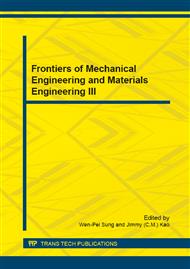[1]
Xu Shaobing, Wu Jianzhou. Overview of New Technology Development of Bloom Casting Domestic and Oversea, J. China Metallurgy, 2008, 18(4): 1-6.
Google Scholar
[2]
Fei Jin, Zhang Weiwen. A Review on the Progress of Continuous Casting Technology, J. Foundry Technology, 2002, 23(2): 74-76.
Google Scholar
[3]
Tooru Matsumiya. Recent Topics of Research and Development in Continuous Casting , J. ISIJ International, 2006, 46 (12): 1800-1804.
DOI: 10.2355/isijinternational.46.1800
Google Scholar
[4]
Zhu Chengyi, Li Guangqiang, Rao Jiangping, etc. Study on the Quality Defects of CC Thin Slab and Its Improving Measurements, J. Shanghai Metals, 2006, 28(2): 15.
Google Scholar
[5]
Cheng Changgui, Che Fang, Shuai Jing, Han Tao, etc. Development of Centerline Segregation Control Technology for Continuous Casting Strand, J. Continuous Casting, 2009 , (6): 39-43.
Google Scholar
[6]
Li Yuntao, Zhang Li, Xu Hongwei. Effect of Strip Feeding Ratio in Molten Steel on Slab Microstructure, J. World Iron & Steel, 2011, (4): 27-30.
Google Scholar
[7]
Li Weibiao, Wang Fang, Qi Fengsheng, Li baokuan. Methematical Model on Steel Strip-feeding of Mold in Continuous Casting Process, J. Acta Metallurgica Sinica, 2007, 43(11): 1191-1194.
Google Scholar
[8]
Li Yuntao, Zhang Li, Xu Hongwei. Melting Process of Steel Strip and Microstructure of Ingot with Steel-strip Fed in Molten Steel, J. Journal of Iron and Steel Research, 2011, 23(11): 54-58.
DOI: 10.1002/srin.201700407
Google Scholar
[9]
Netto T A. Ferraz U S. Esterfen S F. The Effect Corrosion Defects on the Burst Pressure of Pipelines, J. Journal of Constructional Steel Research, 2005(61): 1185-1204.
DOI: 10.1016/j.jcsr.2005.02.010
Google Scholar
[10]
Kushnarev A V. Supov A V. Khrulev A E, etc.Shcherbakov. Determination of the Heat-transfer Factor Characterizing Sprayer Cooling of Continuously Cast Blanks, J. Metal Science and Treatment, 2007, 49(9-10): 497-500.
DOI: 10.1007/s11041-007-0092-8
Google Scholar
[11]
Choudhary S K. Suvankar Ganguly. Morphology and Segregation in Continuously Cast High Carbon Steel Billets, J. ISIJ International, 2007, 24(12): 1759-1766.
DOI: 10.2355/isijinternational.47.1759
Google Scholar


